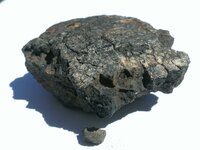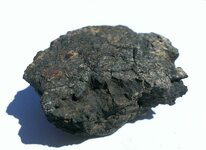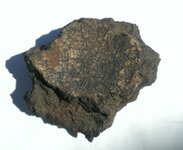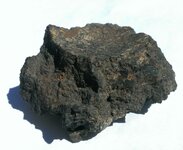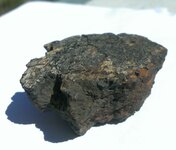Navigation
Install the app
How to install the app on iOS
Follow along with the video below to see how to install our site as a web app on your home screen.
Note: This feature may not be available in some browsers.
More options
You are using an out of date browser. It may not display this or other websites correctly.
You should upgrade or use an alternative browser.
You should upgrade or use an alternative browser.
Meteorite or not?
- Thread starter endrust
- Start date
-
- Tags
- meteorite ?
josmcclellan
Newbie
- Aug 9, 2015
- 3
- 0
- Primary Interest:
- All Treasure Hunting
From your measurements I'm getting 145g/51.52cm3 = 2.81 g/cm3. Could you maybe get a better volume measurement using water and a graduated cylinder?
Here is a link to average meteorite densities.dens
ity & specific gravity of meteorites
Here is a link to average meteorite densities.dens
ity & specific gravity of meteorites
Last edited:
- Thread starter
- #3
From your measurements I'm getting 145g/51.52cm3 = 2.81 g/cm3. Could you maybe get a better volume measurement using water and a graduated cylinder?
Here is a link to average meteorite densities.dens
ity & specific gravity of meteorites
Thanks for your answer. I've made measurements with water and got 145g/33,5cm3 = 4,33 g/cm3. It means that it could be a stony-iron meteorite. Maybe there is some other way to identify is this a meteorite or not? Because I'm having some uncertainties about meteorite/ore origin of this thing. Thanks!
4reale
Jr. Member
- Jul 29, 2008
- 40
- 21
- Detector(s) used
- Fisher CZ 20
- Primary Interest:
- Beach & Shallow Water Hunting
It would also make things easier if you had included the author of the book you're referring to, as there are 27 of them in my library system with that title.
That would be the book by Richard Norton. It has been mentioned in the Meteorite section of the forum many times. However, since there are 27 by that title in your local library system, I would suggest you read all that may pertain to meteorites. After all, knowledge is power.
- Jun 26, 2008
- 7,786
- 11,136
- Detector(s) used
- Ace 250 (2), Ace 300, Gold Bug 2, Tesoro Cortes, Garrett Sea Hunter, Whites TDI SL SE, Fisher Impulse 8, Minelab Monster 1000, Minelab CTX3030, Falcon MD20, Garrett Pro-pointer, Calvin Bunker digger.
- Primary Interest:
- Metal Detecting
Might I just say that "ferrous" and "magnetic" are pretty much the same thing, meaning, if it is magnetic, it has a definite amount of iron. Magnetic=ferrous. Your detector is not lying. They are incapable of lying. It is just "guessing" based on the criteria presented. You may assume that ANY magnetic rock has a certain amount of iron. TTC
- Jun 26, 2008
- 7,786
- 11,136
- Detector(s) used
- Ace 250 (2), Ace 300, Gold Bug 2, Tesoro Cortes, Garrett Sea Hunter, Whites TDI SL SE, Fisher Impulse 8, Minelab Monster 1000, Minelab CTX3030, Falcon MD20, Garrett Pro-pointer, Calvin Bunker digger.
- Primary Interest:
- Metal Detecting
As an avid meteorite collector, you need to purchase O Norton's Field Guide to Meteors and Meteorites. On pages 251 and 251 he gives two ways to test for nickel in your rock. Iron/nickel in rocks is so rare that it is the definitive test for meteorites. TTCThanks for your answer. I've made measurements with water and got 145g/33,5cm3 = 4,33 g/cm3. It means that it could be a stony-iron meteorite. Maybe there is some other way to identify is this a meteorite or not? Because I'm having some uncertainties about meteorite/ore origin of this thing. Thanks!
- Jun 26, 2008
- 7,786
- 11,136
- Detector(s) used
- Ace 250 (2), Ace 300, Gold Bug 2, Tesoro Cortes, Garrett Sea Hunter, Whites TDI SL SE, Fisher Impulse 8, Minelab Monster 1000, Minelab CTX3030, Falcon MD20, Garrett Pro-pointer, Calvin Bunker digger.
- Primary Interest:
- Metal Detecting
O Richard Norton. Rocks From Space. Has a fiery rock on the cover. A classic. TTCThat would be the book by Richard Norton. It has been mentioned in the Meteorite section of the forum many times. However, since there are 27 by that title in your local library system, I would suggest you read all that may pertain to meteorites. After all, knowledge is power.
Al D
Bronze Member
Looks like a lava bomb to me, notice the convex side and the concave side, still, it is a great specimen.
Top Member Reactions
-
 3343
3343 -
 1971
1971 -
 1930
1930 -
 1182
1182 -
 1098
1098 -
 897
897 -
 810
810 -
 805
805 -
 798
798 -
 792
792 -
 774
774 -
 531
531 -
 494
494 -
 460
460 -
 443
443 -
 429
429 -
 425
425 -
 423
423 -
E
414
-
 386
386
Users who are viewing this thread
Total: 2 (members: 0, guests: 2)
